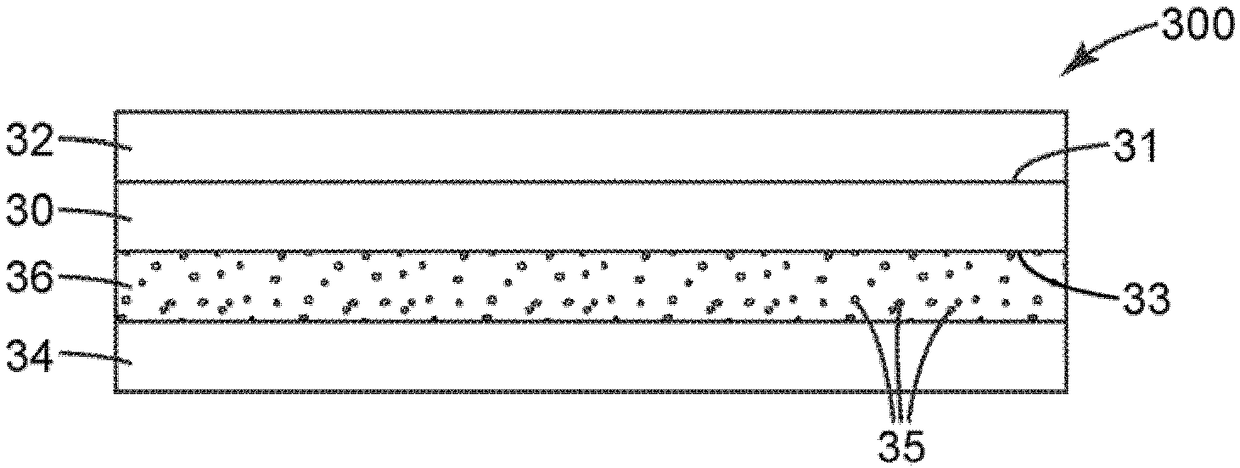Multilayer construction including barrier layer and sealing layer
A barrier layer and sealing layer technology, which is applied in coatings, layered products, chemical instruments and methods, etc., can solve problems such as the impact of barrier layer barrier properties, and achieve good barrier properties
- Summary
- Abstract
- Description
- Claims
- Application Information
AI Technical Summary
Problems solved by technology
Method used
Image
Examples
Embodiment
[0180] These examples are for illustrative purposes only, and are not intended to unduly limit the scope of the appended claims. Notwithstanding that the numerical ranges and parameters setting forth the broad scope of the disclosure are approximations, the numerical values set forth in the specific examples are reported as precisely as possible. Any numerical value, however, inherently contains certain errors necessarily resulting from the standard deviation found in their respective testing measurements. At the very least, and without attempting to limit the application of the doctrine of equivalents to the scope of the claims, each numerical parameter should at least be construed in light of the number of reported significant digits and by applying ordinary rounding techniques.
[0181] Material summary
[0182] All parts, percentages, ratios, etc. in the examples, as well as in the remainder of the specification, are by weight unless otherwise indicated. Table 1 prov...
preparation example 1—
[0189] Preparation Example 1—Vinyl SSQ Synthesis :
[0190] Vinyl SSQ was synthesized as follows: 100 g (0.52 moles) of vinyltriethoxysilane, 50 g of distilled water, and 1.0 g of tartaric acid were mixed together at room temperature in a 500 mL round bottom flask equipped with a condenser. The mixture was stirred at room temperature and an exotherm was observed after stirring for 20 minutes; the temperature was then maintained at 70° C. for 3 to 4 hours. To encapsulate the silanol groups, 80 g of ethoxytrimethylsilane were added to the reaction mixture, which was then stirred at 70° C. for 3 hours. Evaporation of the solvent yielded the vinyl silsesquioxane as a viscous liquid which was dissolved in 200 mL of heptane. The heptane solution was passed through a 1 micron filter paper, resulting in separation of insoluble tartaric acid. The heptane at 100° C. evaporates and yields the vinylsilsesquioxane with reduced silanol end groups as a viscous liquid under reduced pressu...
preparation example 2—
[0191] Preparation Example 2—Synthesis of Acrylate SSQ :
[0192] Acrylate SSQ was synthesized as follows: 2643 g of methacryl silsesquioxane (MA-SSQ monomer) was added to 1000 g of water and 5 g of HCl (37%), and the mixture was stirred at room temperature until observed emission. hot. After stirring for another 5 minutes, 289.5 g of hexamethyldisiloxane were added as an encapsulating agent to encapsulate the silanol groups. The mixture was stirred at 30°C for 8 hours. Solvent evaporation by distillation under reduced pressure yielded viscous MA-SSQ. Next, the viscous liquid was dissolved in 500 mL of MEK and washed once in the separatory funnel with 800 mL of water, then the water was separated from the MEK solution and removed from the bottom of the separatory funnel. The MEK of the organic phase was re-evaporated by distillation under reduced pressure to obtain the final product of MA-SSQ as an optically clear viscous liquid. The silanol group in the acrylate SSQ was...
PUM
| Property | Measurement | Unit |
|---|---|---|
| thickness | aaaaa | aaaaa |
| thickness | aaaaa | aaaaa |
| thickness | aaaaa | aaaaa |
Abstract
Description
Claims
Application Information
 Login to View More
Login to View More - R&D
- Intellectual Property
- Life Sciences
- Materials
- Tech Scout
- Unparalleled Data Quality
- Higher Quality Content
- 60% Fewer Hallucinations
Browse by: Latest US Patents, China's latest patents, Technical Efficacy Thesaurus, Application Domain, Technology Topic, Popular Technical Reports.
© 2025 PatSnap. All rights reserved.Legal|Privacy policy|Modern Slavery Act Transparency Statement|Sitemap|About US| Contact US: help@patsnap.com



